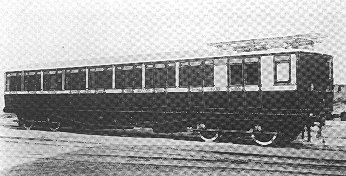
Suburban Electric Railway Association
Located at the COVENTRY ELECTRIC RAILWAY CENTRE, Rowley Road, Baginton, Warwickshire
Established
1996
The History Zone
The Southern Suburban Electric Network
Part 1 - A Tale Of Two Systems
The early story of the development of the Southern electric commuter lines begins with the early electrification work carried out by two of the constituent companies of the Southern Railway:
The London, Brighton & South Coast Railway
In 1903 the LB&SCR obtained powers to electrify their lines and opted to use an overhead wire system that supplied 6,700v. The first line chosen for conversion was the South London Line from London Bridge to Victoria via Peckham Rye (where new car servicing sheds were built). The electrification was completed in 1909 with full public service of the electric trains comencing on December the 1st of that year. To provide the service eight three car sets were built for the LB&SC by the Metropolitan Amalgamated Carriage & Wagon Company, the units were formed of a third class driving motor brake either side of a first class trailer, the current collection was by bow collector mounted above the brake van behind each cab with one provided for each direction of travel and the traction motors of which there were two per motor car were fitted to both axles of the leading bogie. All vehicles in the set were just over 63 feet long.

The success of the South London electrification prompted the LB&SCR to extend the system with the lines from Victoria and London Bridge to Crystal Palace via Streatham Hill opened to electric traction for public use on the 1st of June 1911. Exactly a year later the section of line from Peckham Rye to West Croydon was also electrified. To serve the needs of the extension a new depot was opened at Selhurst and thirty two car sets formed of driving motor and driving trailer vehicles was also provided.
The LB&SCR wished to make further extensions but their plans were interrupted by the outbreak of World War One and it was not until 1918 that they could reconsider their plans, which by then envisaged a main line electrification to Brighton and Eastbourne. However the next (and as it turned out, the last) extension took the overhead wires down th Brighton main line to Coulsdon North and on the busy section to Sutton. Stock for this section was built by Metropolitan C&W and comprised sixty driving trailers, twenty intermediate trailers and to provide traction power twenty one driving motor vans. The later were essentially an electric locomotive, with each axle of both bogies driven by a 250hp traction motor, they also had a cab at each end and in addition they also had the guards brake and luggage space provided. One van was marshalled in the middle of a set with varying numbers of trailers and driving trailers at either end.
The London & South Western Railway
The LSWR announced plans to electrify their innermost suburban lines from Waterloo in 1913. The choice of electrification to be used was made after a fact finding visit to the Lancashire & Yorkshire railway's Liverpool - Southport line where a DC conductor rail collector system had been in use since 1904. The LSWR also opted for a side conductor rail with top contact for collector shoes on the electric stock, the live rails were to be energised at 600v with negative return effected via the running rails.
The routes to be electrified were:
- Waterloo - Wimbledon (via Earlsfield & East Putney)
- Point Pleasant Junction - Wimbledon (via Twickenham & Kingston)
- Shacklegate Junction & Strawberry Hill - Shepperton
- New Malden - Hampton Court
- Surbiton - Guildford (via Cobham)
- Barnes - Twickenham (via Hounslow)
To supply electricity to the system the LSWR built its own power station at Durnsford Road in Wimbledon where new car sheds were also built to house the 84 three car units constructed at the LSWR workshops at Eastleigh for the electric service. The units were formed of a pair of driving motor brake coaches marshalled either end of a trailer composite. All passenger accommodation was in compartments with the guards brake being behind each cab end, under which was mounted the power bogie which had one 275hp motor for each axle giving a total of 1100hp for each three car set. The cab ends had a blunt 'V' appearance and under the bab windows jumper cables were provided to enable sets to work in multiple. Between the cab windows was a headcode box where a stencil denoting a letter of the alphabet was placed, the letter indicated which route the train was booked to run over. The units had automatic Westinghouse air brakes and all electrical equipment was provided by BWE. The bodies were mounted on standard LSWR 57 foot suburban under frames made of timber.
The network opened for electric traction progressively, the first section was that from Waterloo to Wimbledon, via East Putney on October 25th 1915, next came the routes from Clapham Junction to Twickenham, Kingston & Shepperton on January 30th 1916 with the Barnes - Hounslow - Twickenham portion opening on March 12th 1916. The section of line from New Malden to Hampton Court went live on June 18th the same year which left the Guildford route left to complete, due to economic reasons brought about by the outbreak of the first world war the planned electrification of this section was cut back to only go as far as Claygate which was switched on on November the 20th 1916
And so began the development of the electric suburban routes south of London. In 1923 the 'Grouping' of the railways saw both the LSWR and the LBSC taken over by the Southern Railway who planned to make far reaching extensions to the network.
